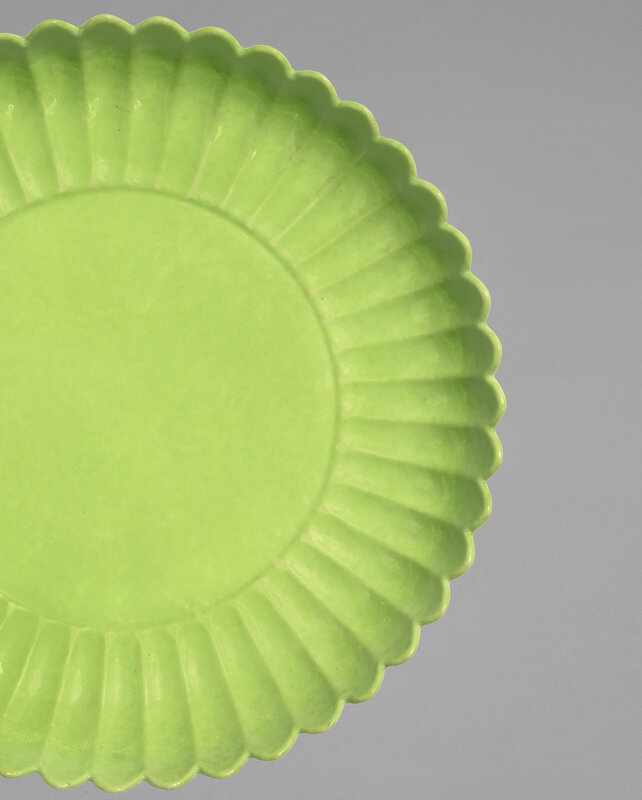A rare lime green-enamelled 'chrysanthemum' dish, Yongzheng mark and period (1723-1735)
Lot 6. A rare lime green-enamelled 'chrysanthemum' dish, Yongzheng mark and period (1723-1735). Diameter 17.8 cm, 7 in. Estimate: 70,000 - 90,000 GBP. Lot sold 112,500 GBP. Photo Sotheby's.
the shallow rounded sides moulded in the form of thirty-four slender fluted petals radiating from a slightly recessed flat centre, supported on a foot of corresponding form, covered overall with an even bright lime-green glaze, the center of the base left white and inscribed with a six-character reign mark within a double circle in underglaze blue.
Exhibited: Zhongguo mingtao riben xunhui zhan. gangtai mingjia shoucang taoci jingpin [Exhibition of Famous Chinese Ceramics Touring Japan. Fine Ceramics from Private Hong Kong and Taiwanese Collections], Nihonbashi Takashimaya, Tokyo, 1992, p. 187.
Note: This chrysanthemum dish is rare for its strikingly brilliant lime-green glaze, one of the rarest and most innovative enamel colour prepared in the Yongzheng period. Containing traces of lead antimonate, a material seldom found on Chinese low-fired glazes, the opaque lime-green enamel embodies the high level of experimentation that characterises Yongzheng imperial porcelain. Peter Y.K. Lam in ‘Qing Monochromes and Tang Ying’, Mille Ans de Monochromes, Fondation Baur, Geneva, 2018, pp 142-171, notes that the lime-green glaze was first used for enamelling on glass in Beijing, and resulted from experiments with pigments imported by Jesuits at the imperial court (p. 158). He further suggests that this enamel colour, together with other innovative enamels produced in Beijing, was first brought to Jingdezhen in 1728 by Tang Ying (1682-1756), who was then appointed Resident Manager of the imperial porcelain factory in Jingdezhen (p. 164).
Only two chrysanthemum-shaped dishes covered in this lime-green glaze and with a Yongzheng mark and of the period appear to be known; the first in the Palace Museum, Beijing, is illustrated together with eleven dishes of this type covered in different monochrome glazes in The Complete Collection of Treasures of the Palace Museum. Monochrome Porcelain, Hong Kong, 1999, pl. 257; and the second was sold in these rooms, 29th March 1977, lot 288.
Dishes of this form and glaze continued to be produced in the succeeding reigns; see for example a Qianlong (r. 1736-95) mark and period example, sold at Christie’s London, 4th June 1973, lot 209; and an unmarked dish attributed to the Jiaqing reign (r. 1796-1820), from the collections of Brodie and Enid Lodge, later in the Meiyintang collection, illustrated in Regina Krahl, Chinese Ceramics in the Meiyintang Collection, vol. 4 (II), 2010, pl. 1833, and sold in our Hong Kong rooms, 23rd October 2005, lot 315.
Sotheby's. Imperial Porcelain - A Private Collection, London, 6 November 2019

/https%3A%2F%2Fprofilepics.canalblog.com%2Fprofilepics%2F1%2F0%2F100183.jpg)
/https%3A%2F%2Fstorage.canalblog.com%2F03%2F02%2F119589%2F96711876_o.jpg)
/https%3A%2F%2Fstorage.canalblog.com%2F11%2F31%2F119589%2F94773502_o.jpg)
/https%3A%2F%2Fstorage.canalblog.com%2F20%2F83%2F119589%2F94772815_o.jpg)
/https%3A%2F%2Fstorage.canalblog.com%2F26%2F72%2F119589%2F75604929_o.jpg)
/https%3A%2F%2Fstorage.canalblog.com%2F59%2F60%2F119589%2F26458628_o.jpg)






/http%3A%2F%2Fstorage.canalblog.com%2F40%2F03%2F119589%2F128175903_o.jpg)
/http%3A%2F%2Fstorage.canalblog.com%2F09%2F24%2F119589%2F126969585_o.jpg)
/http%3A%2F%2Fstorage.canalblog.com%2F77%2F78%2F119589%2F126516458_o.jpg)
/http%3A%2F%2Fstorage.canalblog.com%2F85%2F64%2F119589%2F120488379_o.jpg)